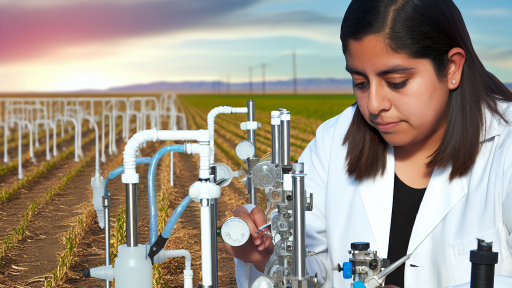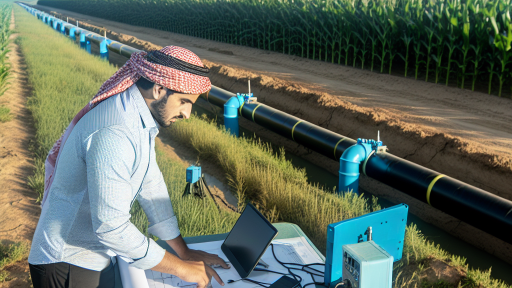Understanding Climate Change: Impact on Agriculture
Overview of Climate Change Effects
Climate change significantly affects agricultural productivity.
Rising temperatures alter growing seasons for various crops.
Increased frequency of extreme weather events disrupt farming activities.
Consequently, farmers must adopt new strategies to cope.
These changes lead to fluctuations in crop yields and quality.
Challenges Faced by Farmers
Farmers worldwide face numerous challenges due to changing climates.
Water scarcity is becoming increasingly common in many regions.
Soil degradation and erosion are on the rise as well.
Additionally, pest and disease pressures intensify in warmer conditions.
This situation forces farmers to rethink traditional methods.
Strategies for Adaptation
Farmers are exploring various strategies to adapt to climate shifts.
Diversifying crops can reduce risk exposure significantly.
Implementing sustainable irrigation methods enhances water usage efficiency.
Using soil conservation techniques helps maintain soil health.
Moreover, integrating technology can optimize agricultural practices.
Transform Your Agribusiness
Unlock your farm's potential with expert advice tailored to your needs. Get actionable steps that drive real results.
Get StartedFuture Implications for Agriculture
The long-term implications of climate change are profound.
Some regions may become unsuitable for traditional crops.
This shift could lead to increased food insecurity globally.
Therefore, proactive measures are vital for sustainable agriculture.
Investing in research and development is essential to innovation.
Ultimately, global collaboration will strengthen agricultural resilience.
Assessing Local Climate Variability: Tools and Techniques
Understanding Climate Variability
Local climate variability significantly affects farming practices.
Farmers must recognize changes in temperature and precipitation patterns.
Additionally, shifts in growing seasons can disrupt traditional timelines.
Utilizing Climate Data
Farmers can access historical climate data for region-specific insights.
Utilizing databases like NOAA and local agricultural extensions is essential.
Moreover, satellite data provides new perspectives on vegetation and heat maps.
Employing Climate Modeling
Climate modeling tools help predict future weather scenarios.
Farmers can adjust strategies based on these predictions effectively.
These models also support decision-making for crop selection.
Incorporating Local Knowledge
Local farmers contribute valuable insights to understanding climate impacts.
Community knowledge often reflects historical adaptations and practices.
Collaboration with agricultural cooperatives can enhance information sharing.
Adopting Technology
Technology can improve real-time monitoring of climatic changes.
Smart agricultural tools, like soil moisture sensors, enhance adaptability.
Furthermore, the use of predictive analytics supports proactive farming decisions.
Implementing Adaptive Practices
Farmers need to test and adopt new agricultural practices regularly.
Crop rotation and diversified planting can build resilience against climate shifts.
Additionally, integrating cover crops helps maintain soil health and moisture.
Showcase Your Farming Business
Publish your professional farming services profile on our blog for a one-time fee of $200 and reach a dedicated audience of farmers and agribusiness owners.
Publish Your ProfileInnovative Crop Selection: Choosing Resilient Varieties
Understanding Climate Resilience
Climate resilience refers to a crop’s ability to withstand environmental changes.
Farmers increasingly prioritize this characteristic in their crop selection.
Resilient varieties can adapt to extreme weather events like droughts and floods.
Moreover, these crops help ensure food security amidst climate uncertainties.
Identifying Suitable Varieties
Farmers should focus on local crop varieties that have thrived historically.
Consulting agricultural extension services aids in identifying resilient families of crops.
Additionally, farmers can join networks to share knowledge on best practices.
Experimenting with New Varieties
Introducing new crop varieties can enhance biodiversity on farms.
Trialing hybrid seeds may reveal more resilient traits for specific conditions.
- Seek seeds from reputable suppliers with proven adaptive characteristics.
- Participate in seed exchanges to obtain diverse crop options.
Utilizing Technology for Crop Selection
Technological advances facilitate better crop selection strategies.
Data analytics can predict which varieties perform well under changing climates.
Moreover, precision agriculture provides insights into field-specific conditions.
Engaging with Traditional Knowledge
Traditional farming techniques often highlight resilience in local crops.
Collaborating with indigenous farmers can yield valuable insights.
This approach supports community-driven adaptation strategies.
Ongoing Evaluation and Adaptation
Regular evaluation of crop performance is essential in adaptive farming.
Farmers must monitor their crops’ resilience to shifting environmental factors.
Recording results helps in making informed decisions for future seasons.
Discover More: Investing in Climate Resilience to Boost Farm Economics
Soil Health Management: Techniques for Adaptation
The Importance of Soil Health
Soyl health plays a crucial role in sustainable farming.
Healthy soil supports plant growth and ecosystem balance.
It also improves water retention and nutrient availability.
Implementing Cover Crops
Cover crops boost soil nutrients between main crops.
They help prevent soil erosion and suppress weeds.
Legumes such as clover can fix nitrogen in the soil.
Farmers can select appropriate cover crops based on local conditions.
Incorporating Crop Rotation
Crop rotation enhances soil fertility and disrupts pest cycles.
Different crops utilize various soil nutrients.
This practice reduces dependency on chemical fertilizers.
Farmers should plan rotations according to crop families.
Practicing No-Till Farming
No-till farming preserves soil structure and biodiversity.
This method reduces soil compaction and erosion.
It also increases organic matter and moisture retention.
Farmers can gradually transition to no-till practices.
Utilizing Organic Amendments
Organic amendments enrich soil with nutrients and microorganisms.
Compost, manure, and biochar are excellent options.
These materials improve soil texture and fertility.
Farmers should apply amendments based on soil tests.
Monitoring Soil Health
Regular soil testing allows farmers to assess health accurately.
Monitoring soil pH, texture, and nutrient levels is essential.
Showcase Your Farming Business
Publish your professional farming services profile on our blog for a one-time fee of $200 and reach a dedicated audience of farmers and agribusiness owners.
Publish Your ProfileFarmers can adjust practices based on test results.
This proactive approach fosters continuous improvement.
Education and Collaboration
Farmers should seek educational resources on soil health.
Collaborating with local agricultural extensions can be beneficial.
Workshops and seminars provide valuable insights and techniques.
Sharing experiences with peers enhances learning and adaptation.
Gain More Insights: Choosing Flood-Resistant Crop Varieties for Your Farm
Water Management Practices: Efficient Irrigation Systems
Importance of Water Conservation
Water conservation is crucial for sustainable farming practices.
It helps to maintain water quality and availability for crops.
Additionally, conserving water reduces costs associated with irrigation.
Farmers must prioritize water-efficient techniques.
Types of Irrigation Systems
Several irrigation systems can enhance water efficiency.
Drip irrigation delivers water directly to plant roots.
This minimizes evaporation and runoff.
Another option is sprinkler irrigation, which simulates rainfall.
It is useful for larger fields and varied crop types.
Implementing Smart Irrigation Technologies
Smart irrigation technologies can optimize water usage.
These systems use sensors to monitor soil moisture levels.
As a result, they adjust water delivery based on crop needs.
Farmers can save significant amounts of water and energy.
Scheduling and Timing of Irrigation
Proper scheduling is key to effective irrigation.
Irrigation should align with local weather conditions.
Farmers can use weather forecasts to plan accordingly.
Watering early in the morning reduces evaporation rates.
Benefits of Rainwater Harvesting
Rainwater harvesting is an effective water management strategy.
This method captures and stores rainwater for future use.
It reduces dependence on municipal water sources.
Moreover, it provides a sustainable water supply for irrigation.
Strategies for Sustainable Agriculture
Efficient irrigation systems are vital for adapting to climate shifts.
Farmers can adopt practices that promote water conservation.
Implementing these strategies leads to more resilient farming.
Ultimately, sustainable water management supports agricultural productivity.
Uncover the Details: Building Resilient Farms Amid Climate Uncertainty

Pest and Disease Management: Adapting to New Threats
Identifying Emerging Pests
Pest populations can shift due to changing climates.
Farmers must regularly monitor fields for unfamiliar species.
Early detection helps reduce potential damage.
Utilize traps and scouting techniques to identify new threats.
Sharing information with local agricultural extensions can be beneficial.
Developing Integrated Pest Management Strategies
Integrating traditional and modern pest control methods is essential.
Use biological controls where possible to maintain equilibrium.
Showcase Your Farming Business
Publish your professional farming services profile on our blog for a one-time fee of $200 and reach a dedicated audience of farmers and agribusiness owners.
Publish Your ProfileAdditionally, consider crop rotation to disrupt pest life cycles.
Encourage beneficial insects that prey on harmful pests.
Maintain healthy soil to support resilient plant systems.
Emphasizing Disease Prevention
Preventive measures can greatly reduce disease outbreaks.
Opt for disease-resistant crop varieties when available.
Clean tools and equipment to minimize disease spread.
Proper irrigation practices can also help prevent fungal diseases.
Monitor weather patterns that may indicate disease risk.
Utilizing Technology for Monitoring
Technology plays a crucial role in modern agriculture.
Drone surveillance can provide valuable field insights.
Smart sensors can track pest and disease levels in real-time.
Farm management software allows for better decision-making.
Collecting and analyzing data supports adaptive strategies.
Collaborating with Experts
Partnerships with agronomists can enhance pest management practices.
Extension services offer valuable resources and training.
Farmers should participate in community workshops and forums.
Networking helps share effective strategies and experiences.
Collaboration leads to more resilient agricultural systems.
Gain More Insights: Assessing the Financial Impacts of Climate Variability on Farms
Integrating Agroforestry: Benefits for Climate Resilience
Enhancing Biodiversity
Agroforestry enhances biodiversity in agricultural landscapes.
This integration provides habitats for various species.
It encourages pollinators, which support crop production.
Moreover, it helps in pest management and disease control.
Improving Soil Health
Incorporating trees into farming systems improves soil health.
Tree roots prevent soil erosion and enhance nutrient cycling.
Additionally, leaf litter contributes organic matter to the soil.
Healthy soils retain moisture more effectively, promoting resilience.
Carbon Sequestration
Agroforestry plays a vital role in carbon sequestration.
Trees absorb carbon dioxide from the atmosphere during photosynthesis.
This process helps mitigate climate change effects significantly.
Furthermore, it promotes healthier ecosystems by reducing greenhouse gas emissions.
Water Management
Effective water management is another key benefit of agroforestry.
Tree canopies reduce water runoff by improving infiltration rates.
This results in better water retention in the soil.
Consequently, crops receive more consistent moisture throughout the growing season.
Economic Resilience
Agroforestry can provide additional income streams for farmers.
Selling timber, fruits, and nuts diversifies farm revenue.
This diversification enhances economic resilience against market fluctuations.
Additionally, it reduces dependency on single crops, promoting stability.
Community Engagement: Sharing Knowledge and Resources
Importance of Local Collaboration
Local collaboration enhances the sharing of farming techniques.
Showcase Your Farming Business
Publish your professional farming services profile on our blog for a one-time fee of $200 and reach a dedicated audience of farmers and agribusiness owners.
Publish Your ProfileFarmers can learn from each other’s experiences directly.
This exchange leads to innovative solutions for climate challenges.
Sharing resources and tools reduces individual costs and efforts.
Moreover, local networks strengthen community resilience.
Organizing Educational Workshops
Workshops allow farmers to gain hands-on experience.
Local agricultural experts can present recent findings.
Farmers can ask questions and clarify doubts immediately.
This interaction fosters a supportive learning environment.
Topics might include crop rotation, pest management, and soil health.
Leveraging Technology for Communication
Technology can facilitate knowledge sharing among farmers.
Social media platforms enable easy communication of best practices.
Online forums allow farmers to discuss challenges and solutions.
By utilizing mobile apps, farmers can access crucial weather information.
This access empowers them to make informed decisions quickly.
Building Partnerships with Local Organizations
Partnerships with local organizations enhance resources available to farmers.
These organizations often provide technical support and training.
They can also help in securing funding for innovative projects.
Furthermore, collaboration with universities enriches research opportunities.
Farmers benefit from cutting-edge scientific knowledge directly.
Creating a Shared Resource Hub
A shared resource hub consolidates tools and information in one place.
Farmers can borrow equipment they may not afford alone.
They can also share seeds and organic fertilizers efficiently.
This hub encourages a spirit of cooperation among community members.
Such a centralized approach can greatly increase productivity.
Additional Resources
Climate Change and Agriculture in the United States: Effects and …
Statements of Support for the Agriculture Resilience Act | U.S. …




